Microstructure Refinement of EB-PVD Gadolinium Zirconate Thermal Barrier Coatings to Improve Their CMAS Resistance
Abstract
:1. Introduction
2. Materials and Methods
2.1. EB-PVD GZO Thermal Barrier Coatings
2.2. CMAS Deposits and Infiltration Experiments
2.3. Characterization Methods
3. Results
3.1. Microstructure of the as-Coated EB-PVD Gadolinium Zirconate Coating
3.2. CMAS Infiltration Experiments
3.2.1. Reaction Products from the GZO-CMAS Interactions Using Powder Mixtures
3.2.2. Effect of Different Microstructures on the Infiltration and Reaction Kinetics
3.2.3. Effect of Chemical Composition of CMAS and Time on the Reaction Kinetics of EB-PVD GZO at 1250 °C
4. Discussion
4.1. Effect of the Process Parameters on the EB-PVD Microstructure
4.2. Effect of the Microstructure on the Infiltration and Reaction Kinetics
4.3. Influence of the Chemical Composition of the CMAS on the Reaction Kinetics
5. Conclusions
- EB-PVD GZO microstructure can be significantly modified by altering the substrate temperature and rotation speed during the coating process. Its microstructural characteristics (such as column diameters, intercolumnar gap width or feather arm length) varied within the range between 50% and 86% and its porosity between 62% and 68% among all the produced microstructures (with reference to the respective maximum value).
- Microstructures that are advantageous for extended CMAS resistance consist of thin columns, narrow intercolumnar gaps, long feather arms, high porosity and a high geometry factor (g), i.e. ratio of intra- to intercolumnar porosity.
- The infiltration kinetics is strongly dependent on the EB-PVD microstructure. For suitable EB-PVD microstructures, the majority of the gap sealing process is achieved within the initial few minutes. Subsequently, the infiltration is stopped or continues only non-linearly.
- The reaction characteristics are partially influenced by the microstructure. Growth of the reaction layer is rather determined by the phase stability, the interchange of ions between reaction phases and the CMAS residue and the morphology of the reaction products. In the case of multi-reaction layers, the microstructure can significantly change the reaction dynamics and phase formations.
- The melt composition plays a major role for the reaction product and kinetics. Different reaction products form as a function of the chemical composition of the CMAS and the residual melt. While apatite and fluorite are formed for all deposits used in the study, the emergence of garnet, spinel and zirconolite is chemistry-dependent.
- The garnet phase is beneficial to the CMAS resistance of TBCs as it incorporates more deposit constituents in a crystalline product and consumes less coating material than the apatite phase. Iron and calcium are key elements in forming garnet and promote its development as a continuous sealing layer. Garnet formation occurs as early as after 10 min at 1250 °C.
Author Contributions
Funding
Institutional Review Board Statement
Informed Consent Statement
Data Availability Statement
Acknowledgments
Conflicts of Interest
References
- Padture, N.P.; Gell, M.; Jordan, E.H. Thermal Barrier Coatings for Gas-Turbine Engine Applications. Science 2002, 296, 280. [Google Scholar] [CrossRef]
- Levi, C.G.; Hutchinson, J.W.; Vidal-Setif, M.H.; Johnson, C.A. Environmental degradation of thermal-barrier coatings by molten deposits. MRS Bull. 2012, 37, 932–941. [Google Scholar] [CrossRef]
- Naraparaju, R.; Lau, H.; Lange, M.; Fischer, C.; Kramer, D.; Schulz, U.; Weber, K. Integrated testing approach using a customized micro turbine for a volcanic ash and CMAS related degradation study of thermal barrier coatings. Surf. Coat. Technol. 2018, 337, 198–208. [Google Scholar] [CrossRef]
- Wellman, R.G.; Nicholls, J.R. Erosion, corrosion and erosion–corrosion of EB PVD thermal barrier coatings. Tribol. Int. 2008, 41, 657–662. [Google Scholar] [CrossRef]
- Steinberg, L.; Naraparaju, R.; Heckert, M.; Mikulla, C.; Schulz, U.; Leyens, C. Erosion behavior of EB-PVD 7YSZ coatings under corrosion/erosion regime: Effect of TBC microstructure and the CMAS chemistry. J. Eur. Ceram. Soc. 2018, 38, 5101–5112. [Google Scholar] [CrossRef]
- Krämer, S.; Yang, J.; Levi, C.G.; Johnson, C.A. Thermochemical Interaction of Thermal Barrier Coatings with Molten CaO–MgO–Al2O3–SiO2 (CMAS) Deposits. J. Am. Ceram. Soc. 2006, 89, 3167–3175. [Google Scholar] [CrossRef]
- Mechnich, P.; Braue, W. Volcanic Ash-Induced Decomposition of EB-PVD Gd2Zr2O7 Thermal Barrier Coatings to Gd-Oxyapatite, Zircon, and Gd, Fe-Zirconolite. J. Am. Ceram. Soc. 2013, 96, 1958–1965. [Google Scholar] [CrossRef]
- Schulz, U.; Braue, W. Degradation of La2Zr2O7 and other novel EB-PVD thermal barrier coatings by CMAS (CaO-MgO-Al2O3-SiO2) and volcanic ash deposits. Surf. Coat. Technol. 2013, 235, 165–173. [Google Scholar] [CrossRef]
- Gomez Chavez, J.J.; Naraparaju, R.; Mechnich, P.; Kelm, K.; Schulz, U.; Ramana, C.V. Effects of yttria content on the CMAS infiltration resistance of yttria stabilized thermal barrier coatings system. J. Mater. Sci. Technol. 2020, 43, 74–83. [Google Scholar] [CrossRef]
- Naraparaju, R.; Chavez, J.J.G.; Schulz, U.; Ramana, C.V. Interaction and infiltration behavior of Eyjafjallajokull, Sakurajima volcanic ashes and a synthetic CMAS containing FeO with/in EB-PVD ZrO2-65 wt% Y-2 O-3 coating at high temperature. Acta Mater. 2017, 136, 164–180. [Google Scholar] [CrossRef]
- Naraparaju, R.; Pubbysetty, R.P.; Mechnich, P.; Schulz, U. EB-PVD alumina (Al2O3) as a top coat on 7YSZ TBCs against CMAS/VA infiltration: Deposition and reaction mechanisms. J. Eur. Ceram. Soc. 2018, 38, 3333–3346. [Google Scholar] [CrossRef]
- Mikulla, C.; Naraparaju, R.; Schulz, U.; Toma, F.-L.; Barbosa, M.; Steinberg, L.; Leyens, C. Investigation of CMAS Resistance of Sacrificial Suspension Sprayed Alumina Topcoats on EB-PVD 7YSZ Layers. J. Therm. Spray Technol. 2020, 29, 90–104. [Google Scholar] [CrossRef]
- Shan, X.; Luo, L.; Chen, W.; Zou, Z.; Guo, F.; He, L.; Zhang, A.; Zhao, X.; Xiao, P. Pore filling behavior of YSZ under CMAS attack: Implications for designing corrosion-resistant thermal barrier coatings. J. Am. Ceram. Soc. 2018, 101, 5756–5770. [Google Scholar] [CrossRef]
- Gildersleeve, E.; Viswanathan, V.; Sampath, S. Molten silicate interactions with plasma sprayed thermal barrier coatings: Role of materials and microstructure. J. Eur. Ceram. Soc. 2019, 39, 2122–2131. [Google Scholar] [CrossRef]
- Rezanka, S.; Mack, D.E.; Mauer, G.; Sebold, D.; Guillon, O.; Vaßen, R. Investigation of the resistance of open-column-structured PS-PVD TBCs to erosive and high-temperature corrosive attack. Surf. Coat. Technol. 2017, 324, 222–235. [Google Scholar] [CrossRef]
- Naraparaju, R.; Huttermann, M.; Schulz, U.; Mechnich, P. Tailoring the EB-PVD columnar microstructure to mitigate the infiltration of CMAS in 7YSZ thermal barrier coatings. J. Eur. Ceram. Soc. 2017, 37, 261–270. [Google Scholar] [CrossRef]
- Naraparaju, R.; Chavez, J.J.G.; Niemeyer, P.; Hess, K.U.; Song, W.J.; Dingwell, D.B.; Lokachari, S.; Ramana, C.V.; Schulz, U. Estimation of CMAS infiltration depth in EB-PVD TBCs: A new constraint model supported with experimental approach. J. Eur. Ceram. Soc. 2019, 39, 2936–2945. [Google Scholar] [CrossRef]
- Kabir, M.R.; Sirigiri, A.K.; Naraparaju, R.; Schulz, U. Flow Kinetics of Molten Silicates through Thermal Barrier Coating: A Numerical Study. Coatings 2019, 9, 332. [Google Scholar] [CrossRef]
- Munawar, A.U.; Schulz, U.; Cerri, G.; Lau, H. Microstructure and cyclic lifetime of Gd and Dy-containing EB-PVD TBCs deposited as single and double-layer on various bond coats (vol 245C, pg 92, 2014). Surf. Coat. Technol. 2015, 279, 53. [Google Scholar] [CrossRef]
- Schulz, U.; Nowotnik, A.; Kunkel, S.; Reiter, G. Effect of processing and interface on the durability of single and bilayer 7YSZ/gadolinium zirconate EB-PVD thermal barrier coatings. Surf. Coat. Technol. 2020, 381, 125107. [Google Scholar] [CrossRef]
- Schulz, U.; Terry, S.G.; Levi, C.G. Microstructure and texture of EB-PVD TBCs grown under different rotation modes. Mater. Sci. Eng. A 2003, 360, 319–329. [Google Scholar] [CrossRef]
- Naraparaju, R.; Schulz, U.; Mechnich, P.; Döbber, P.; Seidel, F. Degradation study of 7wt.% yttria stabilised zirconia (7YSZ) thermal barrier coatings on aero-engine combustion chamber parts due to infiltration by different CaO–MgO–Al2O3–SiO2 variants. Surf. Coat. Technol. 2014, 260, 73–81. [Google Scholar] [CrossRef]
- Naraparaju, R.; Mechnich, P.; Schulz, U.; Rodriguez, G.C.M. The Accelerating Effect of CaSO4 Within CMAS (CaO-MgO-Al2O3-SiO2) and Its Effect on the Infiltration Behavior in EB-PVD 7YSZ. J. Am. Ceram. Soc. 2016, 99, 1398–1403. [Google Scholar] [CrossRef]
- Schmitt, M.P.; Rai, A.K.; Bhattacharya, R.; Zhu, D.; Wolfe, D.E. Multilayer thermal barrier coating (TBC) architectures utilizing rare earth doped YSZ and rare earth pyrochlores. Surf. Coat. Technol. 2014, 251, 56–63. [Google Scholar] [CrossRef]
- Munawar, A.U.; Schulz, U.; Cerri, G. Microstructural Evolution of GdZ and DySZ Based EB-PVD TBC Systems After Thermal Cycling at High Temperature. J. Eng. Gas Turbines Power 2013, 135, 6. [Google Scholar] [CrossRef]
- Gomez Chavez, J.J.; Naraparaju, R.; Mikulla, C.; Mechnich, P.; Kelm, K.; Ramana, C.V.; Schulz, U. Comparative Study of EB-PVD Gadolinium-Zirconate and Yttria-rich Zirconia Coatings Performance against Fe-containing Calcium-Magnesium-Aluminosilicate (CMAS) Infiltration. Corros. Sci. 2021, 190, 109660. [Google Scholar] [CrossRef]
- Nieto, A.; Agrawal, R.; Bravo, L.; Hofmeister-Mock, C.; Pepi, M.; Ghoshal, A. Calcia–magnesia–alumina–silicate (CMAS) attack mechanisms and roadmap towards Sandphobic thermal and environmental barrier coatings. Int. Mater. Rev. 2021, 66, 451–492. [Google Scholar] [CrossRef]
- Renteria, A.F.; Saruhan, B.; Schulz, U.; Raetzer-Scheibe, H.J.; Haug, J.; Wiedenmann, A. Effect of morphology on thermal conductivity of EB-PVD PYSZ TBCs. Surf. Coat. Technol. 2006, 201, 2611–2620. [Google Scholar] [CrossRef]
- Wolfe, D.E.; Singh, J.; Miller, R.A.; Eldridge, J.I.; Zhu, D.-M. Tailored microstructure of EB-PVD 8YSZ thermal barrier coatings with low thermal conductivity and high thermal reflectivity for turbine applications. Surf. Coat. Technol. 2005, 190, 132–149. [Google Scholar] [CrossRef]
- Jang, B.K.; Matsubara, H. Influence of rotation speed on microstructure and thermal conductivity of nano-porous zirconia layers fabricated by EB-PVD. Scr. Mater. 2005, 52, 553–558. [Google Scholar] [CrossRef]
- Schulz, U.; Fritscher, K.; Leyens, C.; Peters, M.; Kaysser, W.A. Thermocyclic Behavior of Differently Stabilized and structured EB-PVD thermal barrier coatings. Mater. Werkst. 1997, 28, 370–376. [Google Scholar] [CrossRef]
- Matsumoto, M.; Wada, K.; Yamaguchi, N.; Kato, T.; Matsubara, H. Effects of substrate rotation speed during deposition on the thermal cycle life of thermal barrier coatings fabricated by electron beam physical vapor deposition. Surf. Coat. Technol. 2008, 202, 3507–3512. [Google Scholar] [CrossRef]
- Ganvir, A.; Joshi, S.; Markocsan, N.; Vassen, R. Tailoring columnar microstructure of axial suspension plasma sprayed TBCs for superior thermal shock performance. Mater. Des. 2018, 144, 192–208. [Google Scholar] [CrossRef]
- Jesuraj, S.A.; Kuppusami, P.; Dharini, T.; Panda, P.; Devapal, D. Effect of substrate temperature on microstructure and nanomechanical properties of Gd2Zr2O7 coatings prepared by EB-PVD technique. Ceram. Int. 2018, 44, 18164–18172. [Google Scholar] [CrossRef]
- Jesuraj, S.A.; Kuppusami, P.; Ajith Kumar, S.; Panda, P.; Udaiyappan, S. Investigation on the effect of deposition temperature on structural and nanomechanical properties of electron beam evaporated lanthanum zirconate coatings. Mater. Chem. Phys. 2019, 236, 121789. [Google Scholar] [CrossRef]
- Park, C.; Choi, S.; Chae, J.; Kim, S.; Kim, H.; Oh, Y.-S. Effect of Substrate Rotation on the Phase Evolution and Microstructure of 8YSZ Coatings Fabricated by EB-PVD. J. Korean Ceram. Soc. 2016, 53, 81–86. [Google Scholar] [CrossRef]
- Renteria, A.F. A Small-Angle Scattering Analysis of the Influence of Manufacture and Thermal Induced Morphological Changes on the Thermal Conductivity of EBPVD PYSZ Thermal Barrier Coatings. Ph.D. Dissertation, RWTH Aachen, Aachen, Germany, 2007. [Google Scholar]
- Yamaguchi, N.; Wada, K.; Kimura, K.; Matsubara, H. Microstructure modification of yttria-stabilized zirconia layers prepared by EB-PVD. J. Ceram. Soc. Jpn. 2003, 111, 883–889. [Google Scholar] [CrossRef]
- Jackson, R.W.; Zaleski, E.M.; Hazel, B.T.; Begley, M.R.; Levi, C.G. Response of molten silicate infiltrated Gd2Zr2O7 thermal barrier coatings to temperature gradients. Acta Mater. 2017, 132, 538–549. [Google Scholar] [CrossRef]
- Karaoglanli, A.C.; Doleker, K.M.; Ozgurluk, Y. Interface failure behavior of yttria stabilized zirconia (YSZ), La2Zr2O7, Gd2Zr2O7, YSZ/La2Zr2O7 and YSZ/Gd2Zr2O7 thermal barrier coatings (TBCs) in thermal cyclic exposure. Mater. Charact. 2020, 159, 110072. [Google Scholar] [CrossRef]
- Kramer, S.; Yang, J.; Levi, C.G. Infiltration-inhibiting reaction of gadolinium zirconate thermal barrier coatings with CMAS melts. J. Am. Ceram. Soc. 2008, 91, 576–583. [Google Scholar] [CrossRef]
- Lavigne, O.; Rio, C.; Vidal-Setif, M.H.; Jaquet, V.; Joulia, A.; Tillard, L. Influence of morphology on thermal properties and CMAS resistance of gadolinium zirconate EB-PVD coatings. In Proceedings of the HELSMAC Symposium, Cambridge, UK, 7–8 April 2016. [Google Scholar]
- Rivera-Gil, M.A.; Gomez-Chavez, J.; Ramana, C.V.; Naraparaju, R.; Schulz, U.; Munoz Saldana, J. High Temperature Interaction of Volcanic Ashes with 7YSZ TBC´s produced by APS: Infiltration behavior and phase stability. Surf. Coat. Technol. 2019, 378, 124915. [Google Scholar] [CrossRef]
- Poerschke, D.L.; Levi, C.G. Phase equilibria in the calcia-gadolinia-silica system. J. Alloys Compd. 2017, 695, 1397–1404. [Google Scholar] [CrossRef]
- Perrudin, F.; Rio, C.; Vidal-Setif, M.H.; Petitjean, C.; Panteix, P.J.; Vilasi, M. Gadolinium oxide solubility in molten silicate: Dissolution mechanism and stability of Ca2Gd8(SiO4)6O2 and Ca3Gd2(Si3O9)2 silicate phases. J. Eur. Ceram. Soc. 2017, 37, 2657–2665. [Google Scholar] [CrossRef]
- Guijosa-Garcia, C.Y.; Rivera-Gil, M.A.; Ramana, C.V.; Naraparaju, R.; Schulz, U.; Muñoz-Saldaña, J. Reaction Products from High Temperature Treatments of (LaxGd1−x)2Zr2O7 System and Volcanic Ash Powder Mixtures. JOM 2022, 74, 2791–2808. [Google Scholar] [CrossRef]
- Mechnich, P.; Braue, W.; Schulz, U. High-Temperature Corrosion of EB-PVD Yttria Partially Stabilized Zirconia Thermal Barrier Coatings with an Artificial Volcanic Ash Overlay. J. Am. Ceram. Soc. 2011, 94, 925–931. [Google Scholar] [CrossRef]
- Poerschke, D.L.; Levi, C.G. Effects of cation substitution and temperature on the interaction between thermal barrier oxides and molten CMAS. J. Eur. Ceram. Soc. 2015, 35, 681–691. [Google Scholar] [CrossRef]
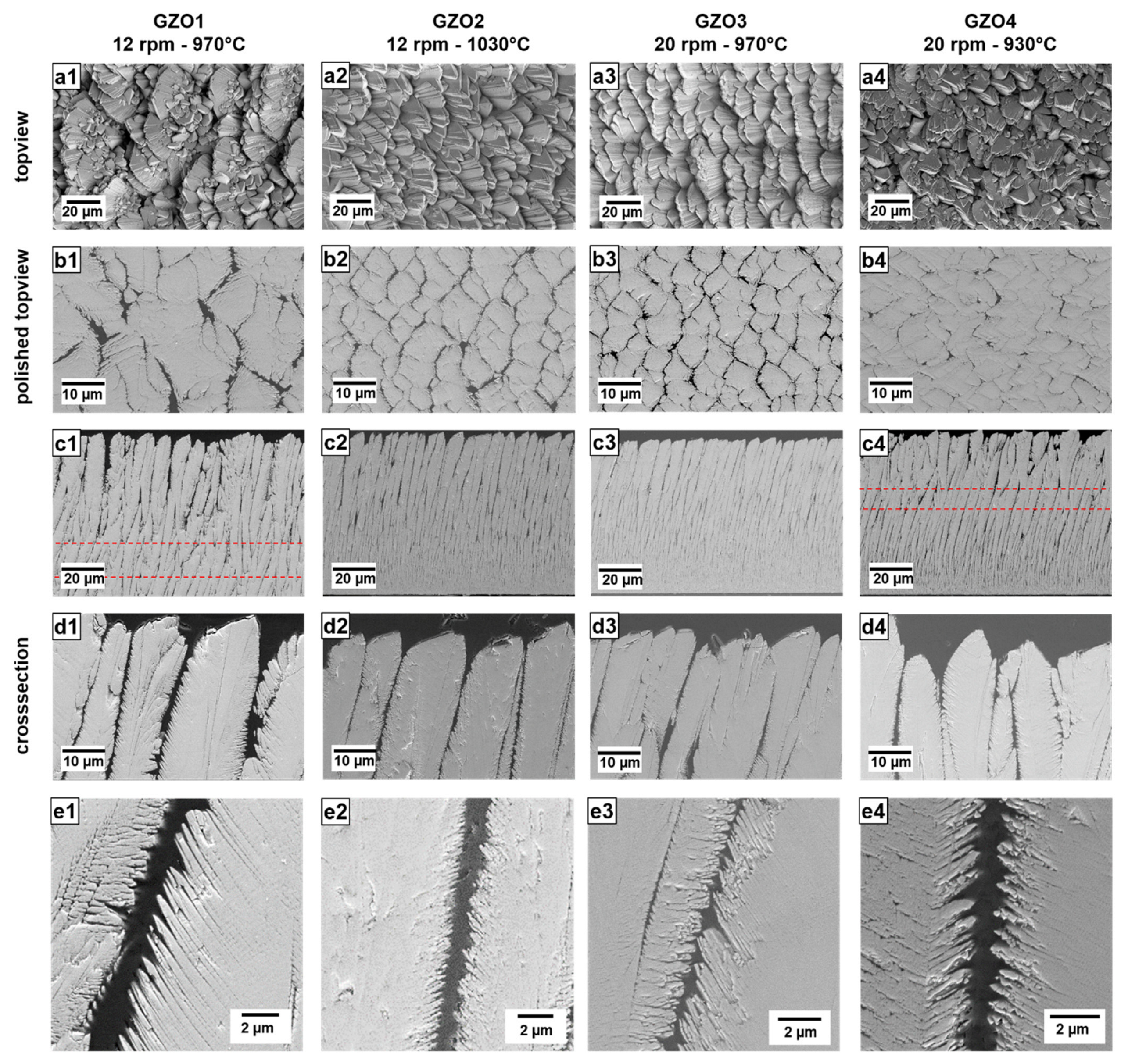

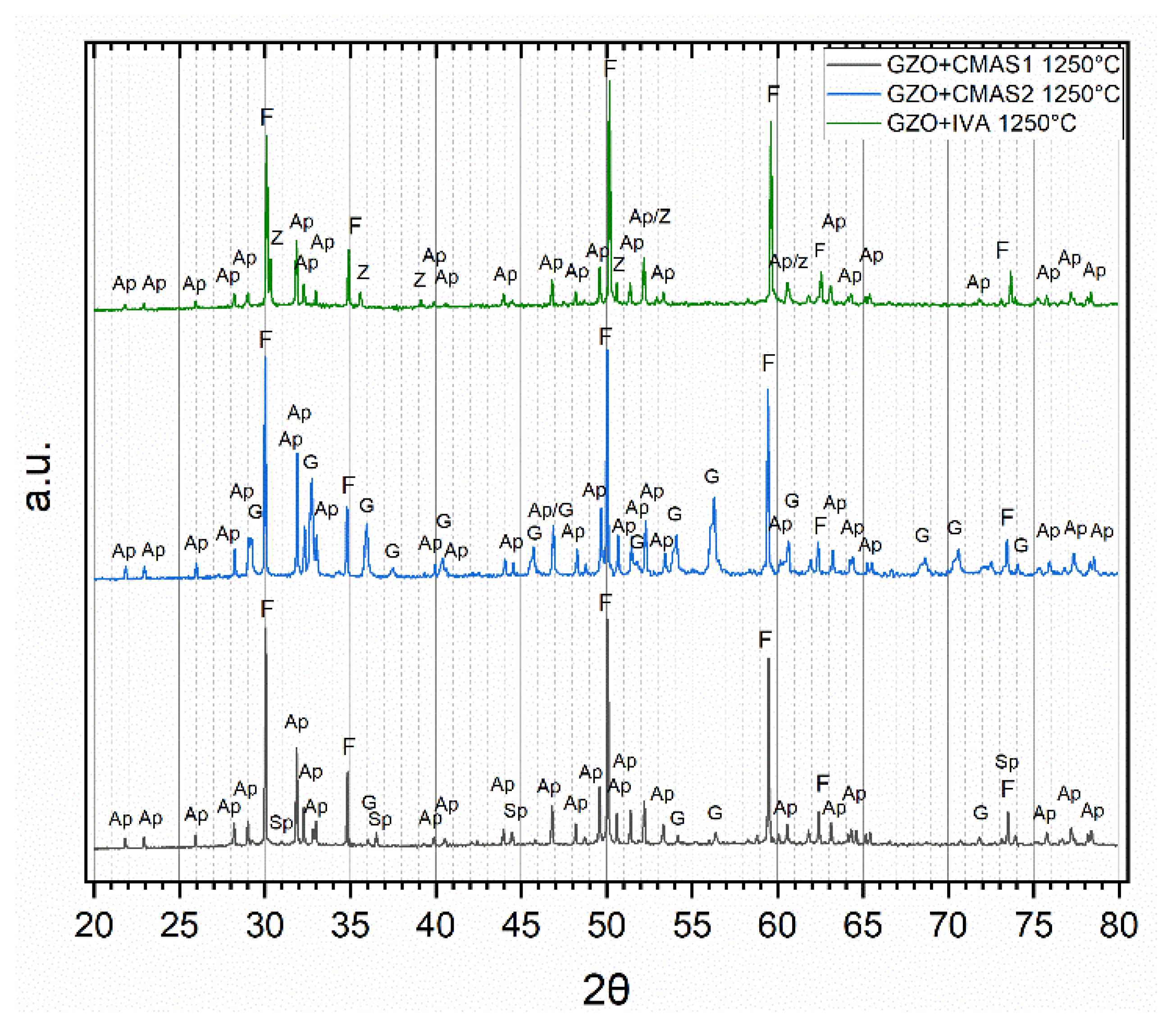




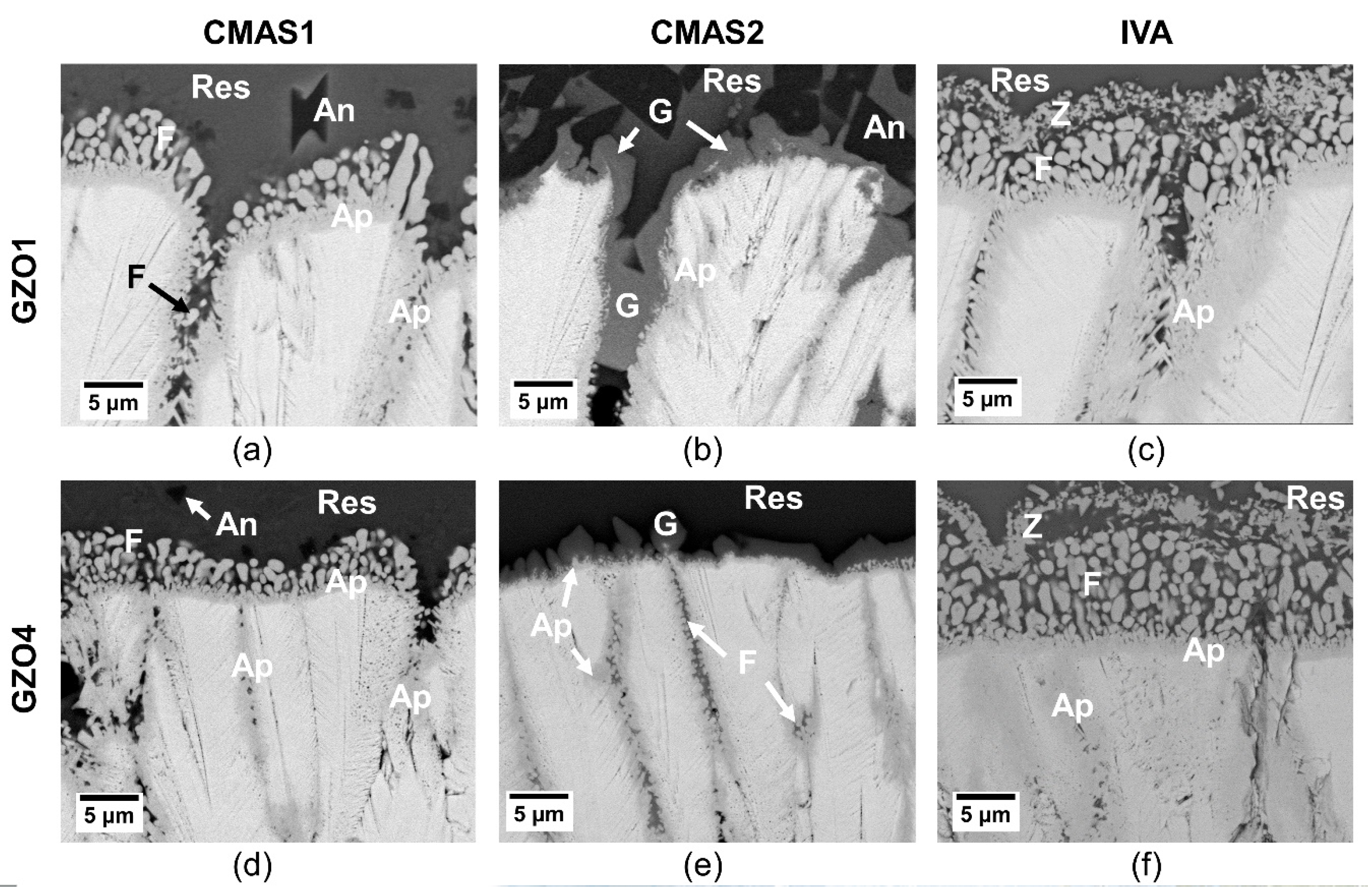
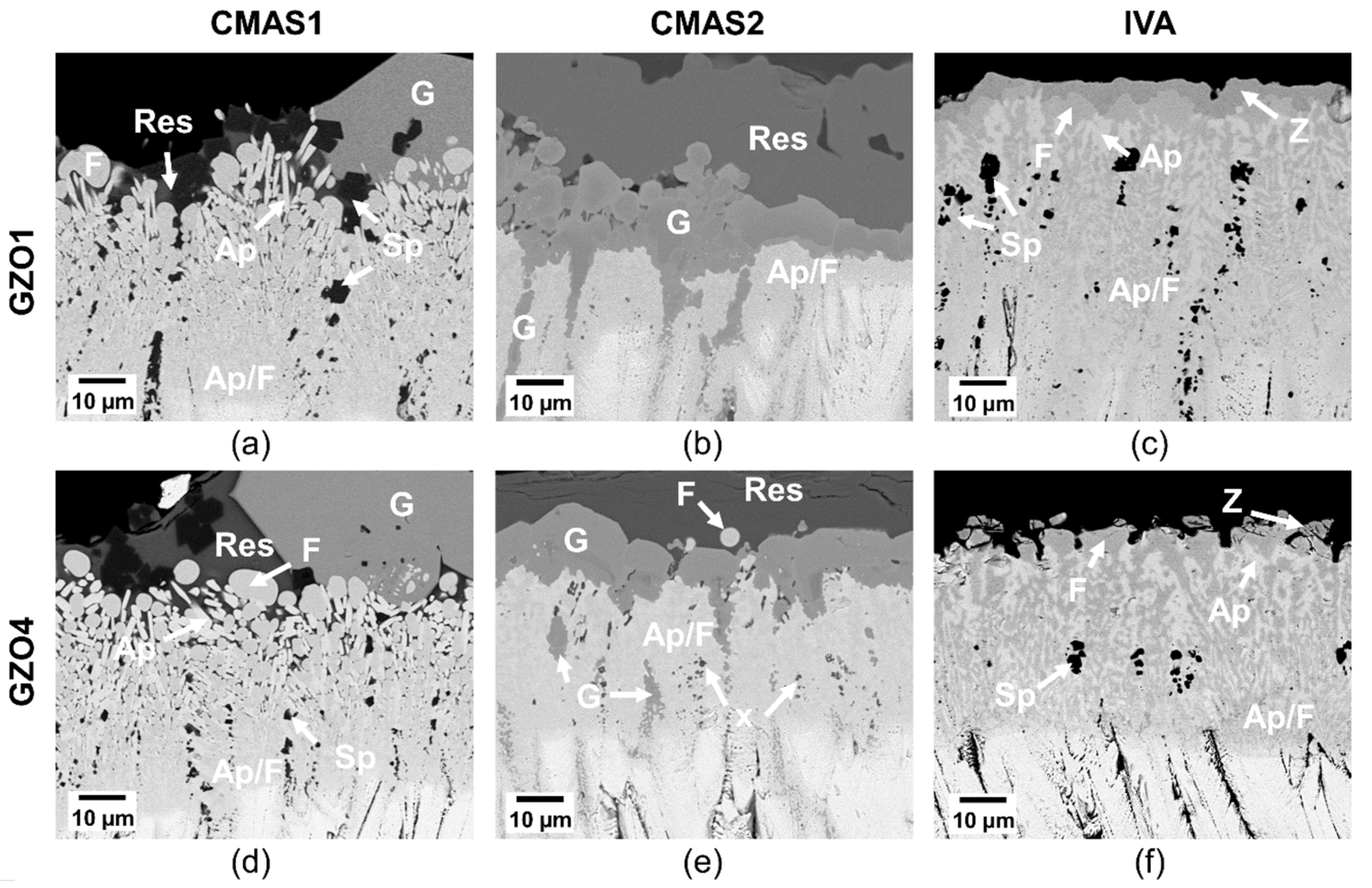
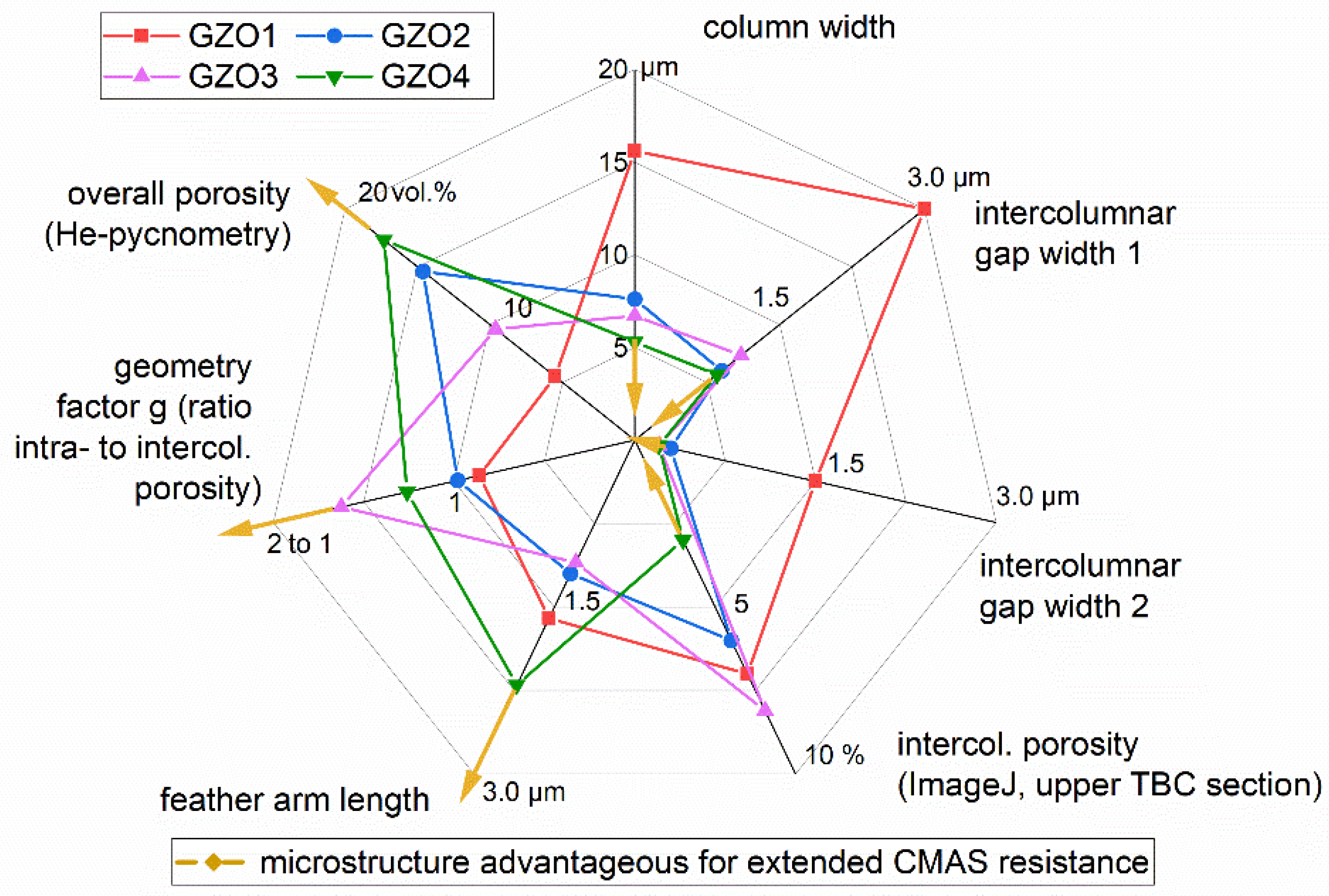
| Process Parameter | GZO1 (12 rpm, 970 °C) | GZO2 (12 rpm, 1030 °C) | GZO3 (20 rpm, 970 °C) | GZO4 (20 rpm, 930 °C) |
|---|---|---|---|---|
| Substrate Temperature | 970 °C | 1030 °C | 970 °C | 930 °C |
| Rotation Speed | 12 rpm | 12 rpm | 20 rpm | 20 rpm |
| Pressure | 6 × 10−3 mbar | |||
| Beam Power | 80–82 kW | 62 kW | 72–76 kW | 72–74 kW |
| Average Coating Thickness | 330 µm | 200 µm | 190 µm | 200 µm |
| Deposit | Chemical Composition [mol.%] | ||||||||||
|---|---|---|---|---|---|---|---|---|---|---|---|
| - | SiO2 | CaO | MgO | Al2O3 | FeO | TiO2 | Na2O | K2O | Melting Range | Viscosity at 1250 °C (exp.) | Main Phases |
| Iceland volcanic ash (IVA) | 49.7 | 12.5 | 6.0 | 7.4 | 17.6 | 4.3 | 2.0 | 0.4 | 1060–1150 °C | 250 Pa·s | Amorphous |
| CMAS1 (synthetic) | 41.6 | 24.7 | 12.3 | 11.1 | 8.7 | 1.6 | - | - | 1230–1250 °C | 6.9 Pa·s | Pyroxene + Anorthite |
| CMAS2 (synthetic) | 37.3 | 32.4 | 11.2 | 9.9 | 7.8 | 1.4 | - | - | 1235–1240 °C | 4.0 Pa·s | Pyroxene + Melillite |
| Characteristics | GZO1 (12 rpm, 970 °C) | GZO2 (12 rpm, 1030 °C) | GZO3 (20 rpm, 970 °C) | GZO4 (20 rpm, 930 °C) |
|---|---|---|---|---|
| Column width | 15.6 ± 1.0 µm | 7.6 ± 1.5 µm | 6.7 ± 1.1 µm | 5.3 ± 1.0 µm |
| Intercolumnar gap width (corners/sides) | 3.0 ± 1.4 µm/ 1.5 ± 0.3 µm | 0.9 ± 0.26 µm/ 0.3 ± 0.06 µm | 1.1 ± 0.3 µm/ 0.2 ± 0.06 µm | 0.85 ± 0.16 µm/ 0.2 ± 0.08 µm |
| Feather arm length | 1.6 ± 0.7 µm | 1.2 ± 0.3 µm | 1.1 ± 0.5 µm | 2.2 ± 0.4 µm |
| Intercolumnar porosity (ImageJ) | ||||
| Top-view | 8.3 ± 0.6% | 6.5 ± 0.9% | 8.2 ± 1.0% | 3.0 ± 0.4% |
| Cross-section | 7.0 ± 1.6% | 6.0 ± 0.9% | 8.1 ± 0.5% | 5.7 ± 0.8% |
| Geometry factor (g) (Ratio of intra to intercolumnar porosity/feather to gap) | 0.86 ± 0.09 to 1 | 0.98 ± 0.410 to 1 | 1.62 ± 0.36 to 1 | 1.26 ± 0.22 to 1 |
| Overall porosity (He-pyknometry) | 5.5 vol.% | 14.6 vol.% | 9.6 vol.% | 17.3 vol.% |
| Deposit | Phase | MgO | AlO1.5 | SiO2 | CaO | TiO2 | FeO | ZrO2 | GdO1.5 | Na2O | K2O |
|---|---|---|---|---|---|---|---|---|---|---|---|
| CMAS1 | Residue | 9.7 | 17.1 | 34.5 | 21.1 | 1.4 | 7.1 | 3.6 | 5.5 | - | - |
| Garnet | 7.5 | 11.7 | 21.1 | 18.4 | 1.9 | 18.1 | 5.1 | 16.2 | - | - | |
| Fluorite | 0.4 | 1.8 | - | 3.4 | 1.4 | 3.1 | 71.4 | 17.9 | - | - | |
| Apatite | 0.5 | 2.9 | 35.0 | 14.3 | - | 0.5 | 3.1 | 43.6 | - | - | |
| Spinel | 30.7 | 51.4 | 1.2 | 0.7 | - | 15.0 | 1.0 | 0.1 | - | - | |
| CMAS2 | Residue | 12.6 | 9.5 | 37.3 | 28.7 | 0.8 | 3.7 | 3.5 | 3.9 | - | - |
| Garnet | 9.2 | 6.3 | 26.3 | 25.0 | 1.7 | 13.7 | 7.8 | 10.0 | - | - | |
| Fluorit | 0.5 | 1.1 | - | 6.2 | 0.9 | 1.8 | 74.0 | 14.7 | - | - | |
| Apatite | - | 1.7 | 34.4 | 18.4 | - | - | 6.5 | 39.0 | - | - | |
| IVA | Residue | 6.2 | 14.3 | 42.7 | 8.1 | 1.7 | 10.2 | 3.6 | 6.8 | 5.4 | 1.0 |
| Zirconolite | - | 4.4 | 4.3 | 2.3 | 20.1 | 18.0 | 28.6 | 21.5 | 0.7 | - | |
| Fluorite | - | 1.2 | 0.2 | 1.0 | 2.5 | 5.3 | 73.3 | 15.8 | - | - | |
| Apatite | - | 2.7 | 35.8 | 11.2 | 0.2 | 1.5 | 5.7 | 42.9 | - | - |
| GZO4, 10 min at 1250 °C [mol.%] | ||||||||||
|---|---|---|---|---|---|---|---|---|---|---|
| Deposit | Label | Phase | MgO | AlO1.5 | SiO2 | CaO | TiO2 | FeO | ZrO2 | GdO1.5 |
| CMAS1 | Res | Residue | 12.2 | 16.4 | 34.8 | 19.6 | 1.4 | 8.0 | 3.2 | 4.5 |
| Ap | Apatite | 0.0 | 1.7 | 21.2 | 11.2 | 0.8 | 0.5 | 30.4 | 34.3 | |
| F | Fluorite | 2.8 | 3.9 | 8.3 | 6.6 | 1.7 | 4.0 | 57.8 | 14.9 | |
| An | Anorthite | 1.2 | 36.6 | 40.1 | 19.2 | - | 2.0 | 0.8 | 0.3 | |
| CMAS2 | Res | Residue | 12.2 | 7.8 | 38.6 | 26.6 | 1.3 | 7.5 | 3.3 | 2.7 |
| G | Garnet | 9.4 | 4.5 | 31.8 | 28.6 | 2.3 | 13.4 | 5.0 | 5.0 | |
| Ap | Apatite | 0.0 | 2.0 | 20.3 | 11.1 | 0.5 | 0.0 | 32.3 | 33.8 | |
| IVA | Res | Residue | 7.8 | 14.5 | 44.1 | 9.3 | 2.2 | 11.4 | 3.8 | 7.0 |
| Z | Zirconolite | 0.8 | 2.6 | 1.4 | 2.0 | 19.8 | 19.2 | 32.4 | 21.9 | |
| Ap | Apatite | - | - | 17.7 | 5.4 | 1.3 | 2.9 | 35.0 | 37.7 | |
| F | Fluorite | 0.6 | 0.7 | - | 1.1 | 3.2 | 5.6 | 70.6 | 18.1 | |
Disclaimer/Publisher’s Note: The statements, opinions and data contained in all publications are solely those of the individual author(s) and contributor(s) and not of MDPI and/or the editor(s). MDPI and/or the editor(s) disclaim responsibility for any injury to people or property resulting from any ideas, methods, instructions or products referred to in the content. |
© 2023 by the authors. Licensee MDPI, Basel, Switzerland. This article is an open access article distributed under the terms and conditions of the Creative Commons Attribution (CC BY) license (https://creativecommons.org/licenses/by/4.0/).
Share and Cite
Mikulla, C.; Steinberg, L.; Niemeyer, P.; Schulz, U.; Naraparaju, R. Microstructure Refinement of EB-PVD Gadolinium Zirconate Thermal Barrier Coatings to Improve Their CMAS Resistance. Coatings 2023, 13, 905. https://doi.org/10.3390/coatings13050905
Mikulla C, Steinberg L, Niemeyer P, Schulz U, Naraparaju R. Microstructure Refinement of EB-PVD Gadolinium Zirconate Thermal Barrier Coatings to Improve Their CMAS Resistance. Coatings. 2023; 13(5):905. https://doi.org/10.3390/coatings13050905
Chicago/Turabian StyleMikulla, Christoph, Lars Steinberg, Philipp Niemeyer, Uwe Schulz, and Ravisankar Naraparaju. 2023. "Microstructure Refinement of EB-PVD Gadolinium Zirconate Thermal Barrier Coatings to Improve Their CMAS Resistance" Coatings 13, no. 5: 905. https://doi.org/10.3390/coatings13050905
APA StyleMikulla, C., Steinberg, L., Niemeyer, P., Schulz, U., & Naraparaju, R. (2023). Microstructure Refinement of EB-PVD Gadolinium Zirconate Thermal Barrier Coatings to Improve Their CMAS Resistance. Coatings, 13(5), 905. https://doi.org/10.3390/coatings13050905








